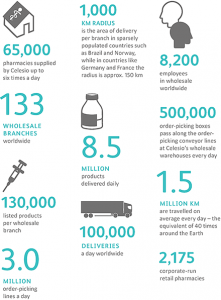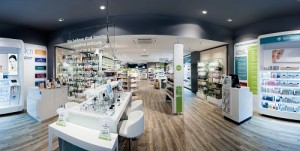Celesio is a leading international wholesale and retail company and provider of logistics and services to the pharmaceutical and healthcare sectors.
It is a German company with headquarters based in Stuttgart.
The proactive and preventive approach ensures that patients receive the products and support that they require for optimum care.
With some 39,000 employees, Celesio operates in 14 countries around the world. Every day, the group serves over 2 million customers – at about 2,200 pharmacies of its own and over 4,300 participants in brand partnership schemes.
With around 130 wholesale branches, Celesio supplies 65,000 pharmacies and hospitals every day with up to 130,000 pharmaceutical products.
The services benefit a patient pool of about 15 million per day.
Facts & Figures
 Celesio’s structure is not dissimilar to the old version of Washington Soul Pattinson at its peak in the 1970’s when it experienced a resurgence that was envied by the pharmacy fraternity. Discounting was also a feature of their network of pharmacies and market research was a primary activity for them.
Celesio’s structure is not dissimilar to the old version of Washington Soul Pattinson at its peak in the 1970’s when it experienced a resurgence that was envied by the pharmacy fraternity. Discounting was also a feature of their network of pharmacies and market research was a primary activity for them.
I remember well, a conversation I had with the manager at their flagship pharmacy at 160 Pitt Street and it is still etched on my memory bank.
Both he and I were keen photographic retailers and he said:
“Neil, as an organisation we have been able to spend a lot of money on a lot of marketing experts and after all this time we have arrived at a conclusion – pharmacists are the best and only experts when promoting their own profession. All they need is the time to be able to do it.
So that’s what we provide to our agents.
We are not wholesalers, we are retail oriented warehouses.”
If you needed proof of the expertise by pharmacists component you only need to point to the current Guild campaign.
After a long time in the wilderness they have finally come to life with an excellent and well thought out campaign.
Like the Washington Soul’s of old, Celesio strives to provide pharmacy excellence and innovation that fulfill patients´ needs and are at the heart of Celesio’s European Pharmacy Network (EPN).
It represents a new kind of pharmacy that changes the way people access healthcare – with a unique store experience, latest services and tools, multi-channel availability, state-of-the-art pharmacy management and highly qualified pharmacy staff.
With a common brand strategy, Celesio aims to give the pharmacies forming part of the EPN a distinctive and consistent appearance across the European markets.
The EPN features a strong and unique health expertise concept through LloydsPharmacy – the UK brand purchased by Celesio, that was trusted and valued by customers and patients for their professional expertise and the deep insight into patient behaviour and needs.
EPN pharmacies are designed to place the customer and patient at the centre of all of Celesio´s activities, providing comprehensive advice on prevention, on general health topics and for the chronically ill as well as offering value-added services such as private consultations.
At the “Health Bar” (which is obviously modelled on Apple’s “genius bar”) customers and patients are able to try products out and access additional healthcare as well as detailed product information through touch screens.
This concept can be immediately copied here in Australia.
 When clients leave a LloydsPharmacy, it is not just medicines that they take away, but a positive feeling leading to improved health and a better quality of life.
When clients leave a LloydsPharmacy, it is not just medicines that they take away, but a positive feeling leading to improved health and a better quality of life.
All of Celesio’s pharmacies are being re-branded as “Lloydspharmacy” and all are being fitted out with “health bars” populated by pharmacists and clinical assistants, blending the multiple skills found in trained staff with a pharmacist overview and perspective.
The EPN concept focuses on giving expert advice and providing services in the areas of skin care and pain control – health issues in these categories are the main reasons for people visiting a pharmacy.
Customers of LloydsPharmacy can benefit, for instance, from a skin analysis service and special pain consultations.
In addition, the pharmacy concept covers compliance management programs that have been tested internationally in Celesio pharmacies, allowing pharmacists to help patients to take their medicines correctly and at the right times.
To free up time for patient consultation, the pharmacy concept also supports pharmacists in the back office management with a state-of-the-art medicines supply chain, built around a recently developed system improving both the delivery of products and the stock management.
At present, the EPN comprises more than 200 concept pharmacies in Great Britain, Italy, Norway, Sweden, Belgium and Ireland.
All of Celesio´s own pharmacies will gradually be refitted to the new pharmacy concept, under the “Lloyds” brand name.
A cooperation scheme is designed to offer the concept to independent partner pharmacies, either as a single package or in individual modules.
In Germany and France the cooperation scheme has already been introduced.
Nearly 500 openings of refitted pharmacies are planned and also more and more independent pharmacies are adopting the concept.
In 2015 and beyond, there is significant potential for further development with Celesio´s 2,200 own pharmacies and 4,300 independent partner pharmacies.
There are similarities with some of the franchised groups here in Australia, but they lack insights (and investment) because they don’t own pharmacies and therefore lack the incentive to go the “last mile” in being a real back-up for actual community pharmacy needs.
Also, services need to be separated out of the supply chain as indeed they have to be physically within a community pharmacy.
As happened many years ago, early in the 20th century, pharmacists banded together to form distributive cooperatives to provide the perceived needs of the day.
Two of those cooperatives survive today in a different form, they being API Ltd and Sigma Pharmaceuticals Ltd.
When the two companies de-mutualised, to everyone’s surprise they found themselves in the top 200 of Australia’s listed companies.
Unfortunately, both companies have not been able to fully match pharmacy needs, although they have created some breakthroughs.
It really does leave room for a pharmacist owned company to rise up and fill the breach.
A pharmacist owned conglomerate based on the Celesio model may achieve the level of trust by pharmacists to achieve the desired results.
It would need some tweaking of the Pharmacy Act to be able to own sufficient pharmacies to be a viable market force, but perhaps allowing up to six pharmacies per pharmacist shareholder might be a possibility.
As they say, it’s worth a thought.
